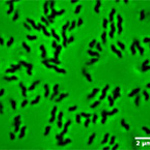You are here:
National Reference Laboratory for Campylobacter

The reservoir for Campylobacter bacteria are warm-blooded wild, farm and domestic animals (birds and mammals), which usually do not show any clinical symptoms of disease. In humans, infectious diseases caused by Campylobacter are mainly associated with diarrhoea. In Germany, as in other European countries, Campylobacter is the most common pathogen of bacterial intestinal infections (enteritis). In Germany, about 70,000 cases of Campylobacter infections are reported to the RKI every year.
Campylobacter infections in humans are mostly food-associated. One of the main sources of infection is insufficiently heated or contaminated poultry meat and the preparation of raw chicken meat with cross-contamination of the bacteria to ready-to-eat food, such as lettuce (see video [in German “Dem Keim auf der Spur”] "Tracing the germ" at the side of this homepage). Other sources of infection can be unpasteurised milk, raw minced meat, untreated drinking water, ingestion of surface water and direct contact to pets.
The National Reference Laboratory for Campylobacter is located at the BfR. The work focuses on routine and research work on the characterisation and differentiation of Campylobacter isolates originating from animals, food and environmental samples. Various molecular biological methods, including whole genome sequencing, are available for epidemiological investigations.
Main activities of the NRL for Campylobacter
The National Reference Laboratory for Campylobacter at BfR has the following main areas of work:
- Performing tasks within the framework of the Zoonoses Monitoring Directive 2003/99/EC.
- Microbiological and molecular diagnostics of Campylobacter spp. and Arcobacter spp.
- Organisation of interlaboratory proficiency tests for qualitative and quantitative detection of Campylobacter in relevant matrices, e.g. chicken meat/skin, raw milk and chicken caecal content
- Production of quantitative reference standards (see our published protocol below)
- Antibiotic resistance testing of Campylobacter spp.
- Support in the elucidation of infection chains
- Molecular fine typing (using MLST, flaA/porA sequencing, cpn60, cgMLST and SNP analysis)
- Molecular analysis of Campylobacter spp. resistance
- Rapid detection by PCR and real-time PCR
- Strain collection
- Consulting
| Team / Tasks | phone | |
|
Dr. Kerstin Stingl Microbiologist (Head of) |
-24206 | |
|
Dr. Janine Heise Micro- and Molecularbiology (Deputy Head of) |
24201 | |
|
Dr. Sarah Brüggemann-Schwarze Microbiologist (Scientific Associate) |
-24207 |
sarah.brueggemann-schwarze@bfr.bund.de
|
|
Christiane Buhler Species differentiation, microbiology, enzyme tests (MTA) |
-24214 |
|
|
Marie-Theres Knüver Species differentiation, next generation sequencing, horizontal gene transfer (Dipl.-Biol.) |
-24220 |
|
|
Maja Thieck Species differentiation, antibiotic resistance (BTA) |
-24202 | maja.thieck@bfr.bund.de |
|
Sandra Preuß Species differentiation, next generation sequencing, horizontal gene transfer (Biotechnologist, B. SC.) |
-24231 | sandra.preuss@bfr.bund.de |
|
Julia Golz Micro- and Molecularbiology (Postdoc) |
-24218 |
julia.golz@bfr.bund.de |
|
Imke Wulsten Micro- and molecular analysis in EsRAM project (PhD student, M. Sc. Biology) |
-24210 |
imke.wulsten@bfr.bund.de |
|
Juan Cruz Goenaga Species differentiation, micro- and molecular biology, antibiotic resistance (Food technologist) |
-24211 | |
|
Michael Zarske Micro- and molecular analysis in CHANCE project (PhD student, M. Sc. Food Technology) |
-24229 | michael.zarske@bfr.bund.de |
Opinion
(2)| Date | Title | Size |
|---|---|---|
|
11.05.2018 BfR Opinion No 011/2018
|
Hygiene for chicken eggs – protection from Campylobacter |
37.5 KB
|
|
13.04.2016 BfR Opinion No 008/2016
|
Raw milk: boiling protects against infection with Campylobacter |
40.4 KB
|
Press releases
(5)| Date | Title | Keywords |
|---|---|---|
|
31.10.2019 41/2019
|
On the trail of pathogens in meat, eggs and raw milk | campylobacter, food infection , food safety , salmonella , zoonoses |
|
11.05.2018 18/2018
|
Campylobacter – the germ on chicken eggs | campylobacter, eggs , foodborne |
|
20.05.2014 11/2014
|
Raw milk: boiling protects against infections | campylobacter, food infection , raw milk , salmonella |
|
17.03.2010 06/2010
|
Chickens frequently contaminated with Salmonella and Campylobacter | |
|
28.01.2008 02/2008
|
Risky delicacy: Pink duck breast |
Communication
(1)| Date | Title | Size |
|---|---|---|
|
30.03.2021 Communication No 012/2021 from the BfR
|
Project PAC-CAMPY: Strategies to combat Campylobacter in a practical test setting |
171.5 KB
|
